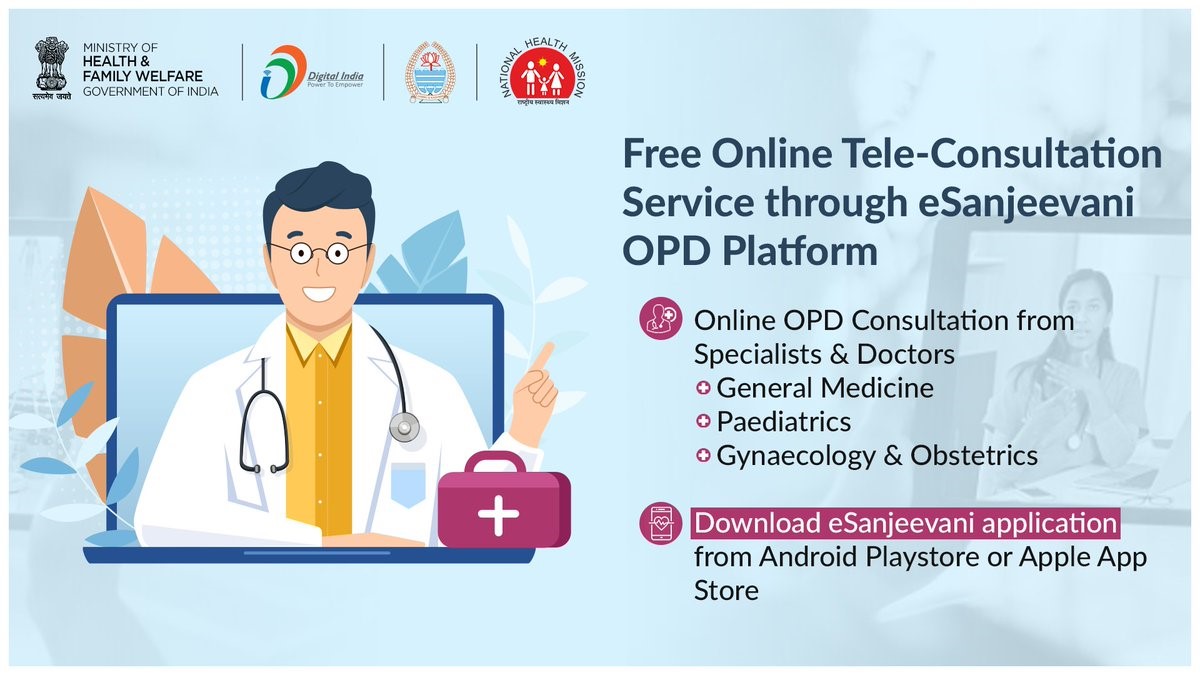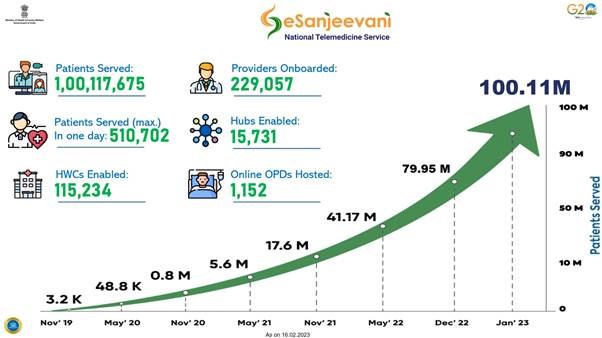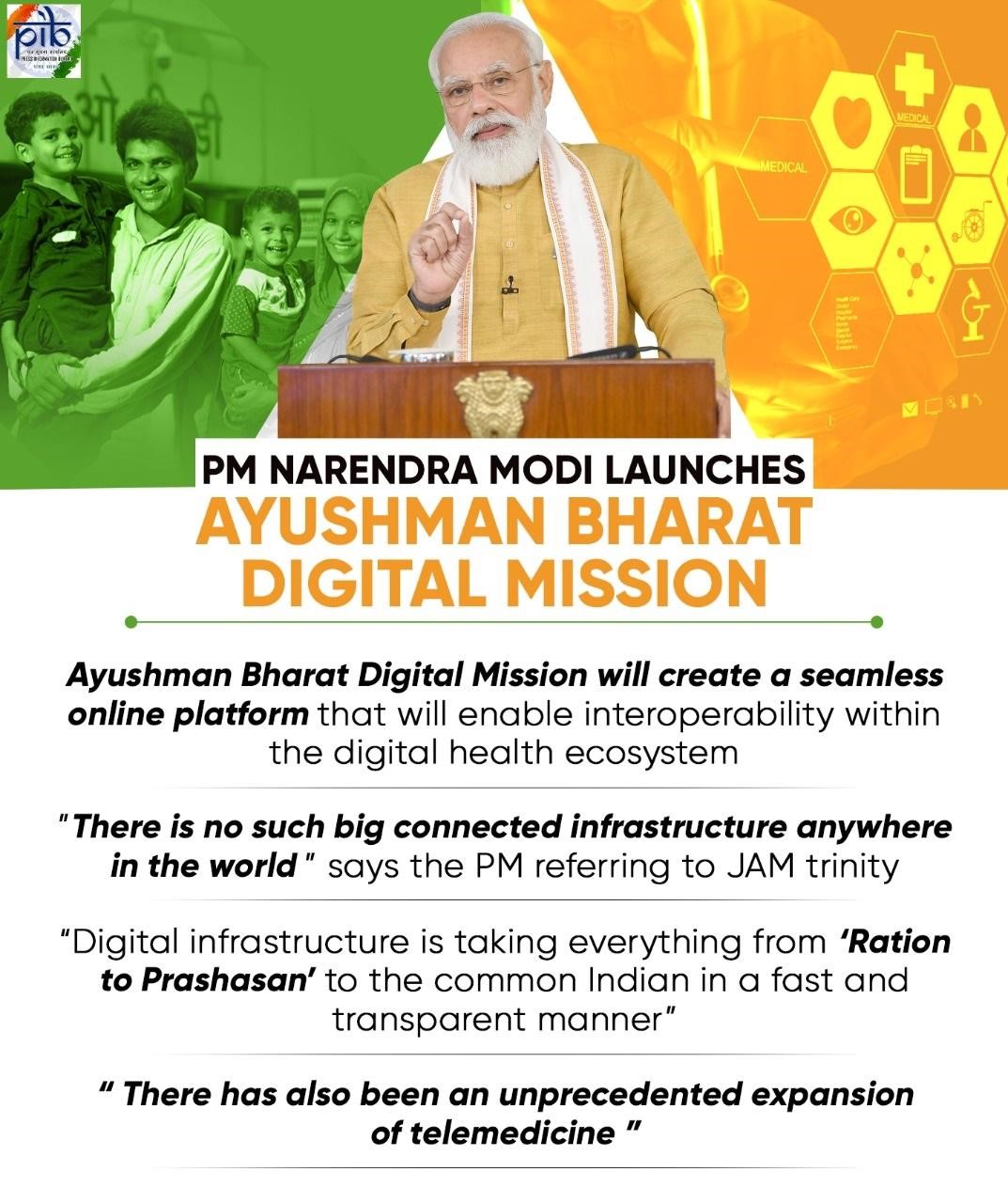01 Mar eSanjeevani
eSanjeevani
This article covers “Daily current events “and the topic is about ‘eSanjeevani’ which is in the news, it covers “Governance” in GS-2 and “Science and Technology” in GS-3, the following content has relevance for UPSC.
For Prelims: eSanjeevani
For Mains: GS-2, Governance; GS-3, Science and Technology
Why in news: In the 98th episode of his regular radio broadcast Mann Ki Baat, Prime Minister Narendra Modi claimed that initiatives like the eSanjeevani had ensured access to medical care for citizens living in remote regions of the nation.

Esanjeevani opd
About eSanjeevani
- A doctor-to-patient telemedicine system is called eSanjeevani.
- The Ministry of Health & Family Welfare has implemented the eSanjeevani scheme across the country.
- eSanjeevani is a key element of the Indian government’s Ayushman Bharat Plan.
- The scheme is especially helpful in times of the pandemic COVID-19 since it prevents individuals from going outside to see a doctor or go to the hospital.
- Anybody can access voice and video medical advice and prescriptions through eSanjeevani OPD.
- With the advent of this service, residents in even the most remote locations will have access to medical consultation.
- This project has earned the title of the largest government-owned telemedicine platform in the world in less than three years.
- eSanjeevani consists of two verticals that provide healthcare services to patients across all states and UTs, so successfully creating a presence in the interior of the nation.
- By offering aided teleconsultations and guaranteeing that Ayushman Bharat Scheme recipients may receive their due benefits, eSanjeevani AB-HWC aims to close the digital health gap between rural and urban areas.
- In this vertical, the “Ayushman Bharat health and Wellness Centers” (HWCs), which are established at the state level and serve as spokes, are mapped with the hub (which consists of MBBS/Specialty/Super-Specialty doctors) at the zonal level.
- The latter vertical, eSanjeevani OPD, offers services to both urban and rural residents. It makes use of technology to enable patient access to doctor consultations via smartphones, tablets, and laptops from anywhere.
Current Trends of Telemedicine

esanjeevani
Telemedicine
- Telemedicine is the practice of physicians diagnosing and treating patients remotely through the use of communications technology such as phone calls, emails, SMS/chat, and video calling. It is a part of the eSanjeevani scheme.
- The Indian telemedicine market with the highest potential is the telemedicine sector, which is predicted to reach $5.4 Billion by 2025.
- The CAGR is currently 39.6%.
- Some well-known telemedicine firms, including Practo, 1mg, mFine, iCliniq, and myUpchar, claimed a 4–9 times increase in doctor consultations between March and June 2020, with about 80% of those users being first-timers on their platforms.
How ESanjeevani Becomes Main Part of Ayushman Bharat Digital Mission

Ayushman Bharat Digital Mission
Objectives of ESanjeevani
- To manage the essential digital health data and the infrastructure under the eSanjeevani scheme needed for its seamless exchange, establish cutting-edge digital health systems.
- Establish registers at the appropriate level to produce a single source of truth regarding clinical facilities, medical personnel, healthcare workers, medications, and pharmacies.
- All national stakeholders in digital health should be compelled to use open standards.
- Establish a system of individual health records based on world standards that are easily available to people and healthcare professionals and service providers and rely on informed consent from the individual.
- Encourage the creation of enterprise-class health application systems with a particular emphasis on attaining the health SDGs.
- Employ the best cooperative federalism principles as you collaborate with the States and Union Territories to make the vision a reality.
- By using a combination of prescription and promotion, make sure that healthcare organizations and professionals in the private sector actively collaborate with public health authorities on the development of the ABDM.
- Make sure that the delivery of health care is portable across the nation. The adoption of clinical decision support (CDS) systems by practitioners and professionals in the medical field is encouraged.
- Promote the management of the health sector by utilizing medical research and health data analytics.
Business Principles
- Wellness-centric and wellness-driven: Real-time access to individual health records would boost wellness centers and mobile screening teams.
- Designed to be inclusive: Encourage and educate people to use a variety of health and wellness services
- Ensure security and privacy by design: In accordance with the PDP Bill 2019, a national policy on the security of health systems and the privacy of individual health records would be created. All the components that must deal with personal health records will be created from the beginning to adhere to this policy.
- Designed to track and display the effectiveness and responsibility of all healthcare professionals: All service levels of the health sector’s performance against agreed-upon KPIs will be monitored in real-time, and results will be disseminated.
- Using a Health ID, a national footprint and seamless portability will be made possible: National mobility will be greatly aided by the Personal Health Identifier and its supporting infrastructure, which includes the implementation of Health Information Standards.
Technology Principles
- By utilizing the India Enterprise Architecture Framework (IndEA): By default, the IndEA standard will be adopted and followed in the design of the ABDM building blocks. MeitY will notify all design and development efforts to use the Agile IndEA Framework.
- Every aspect of ABDM will use federated architecture: There will only be central development and maintenance of the defined Core Building Blocks. Every other component will be created with the intention of operating in a federated paradigm that takes into account regional, state, and institutional platforms and systems while yet allowing them to work together. The information would be federated as per ABDM specifications and stored near the place of origination.
- The ABDM ecosystem will be based on Open APIs: The Open API Policy announced by MeitY, GoI will be adopted by all building blocks, and they will all share data in accordance with the requirements outlined in NDHB. The design and development of the APIs will incorporate security and privacy considerations, which should be reviewed before implementation.
- All significant legacy systems will be examined for compliance with NDHB principles and will be utilized to the greatest extent possible.
Building Blocks
- Health ID: The Health ID will be used to identify people in a unique way, verify their identity, and connect their health records to other systems and stakeholders under the ESanjeevani Scheme
(but only with the patient’s informed consent). - Healthcare Professionals Registry: It is a complete database of all healthcare professionals engaged in the provision of healthcare services in both contemporary and conventional medical systems. They will be connected to India’s ecosystem of healthcare ecosystem by enrolling in the Healthcare Professionals Registry Registry.
- Health Facility Registry: It is a thorough database of the country’s medical facilities from various medical systems. It consists of both governmental and private healthcare facilities, such as clinics, hospitals, diagnostic centers, imaging centers, and pharmacies.
- ABHA Mobile App: A PHR (Personal Health Record) is an electronic record of a person’s health-related information that complies with nationally accepted interoperability standards, may be obtained from various sources, and is managed, shared, and controlled by the person. The fact that the PHR puts the user in control of the information it holds, distinguishing it from the EMR and EHR, is its most salient feature.
Sources
Daily Current Affairs for UPSC
PLUTUS IAS CURRENT AFFAIRS 1 march 2023
Daily Current Affairs play a significant role in the UPSC examination. The topic described above is based on eSanjeevani which is related to the latest daily current affairs for the UPSC examination. these are the key elements of the UPSC exam preparation. Get such kinds of the latest and best daily current affairs for the UPSC examination. Also, read the weekly and monthly current affairs form IAS exam preparation.



No Comments